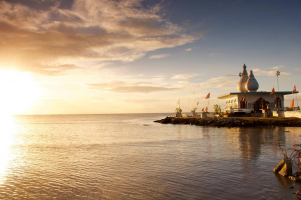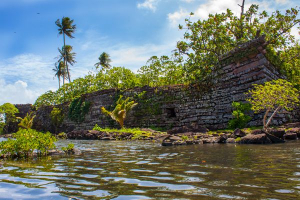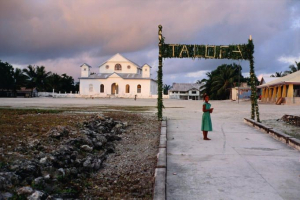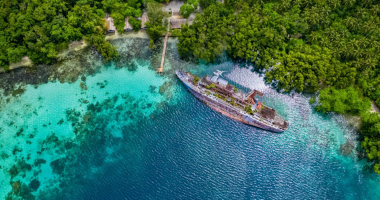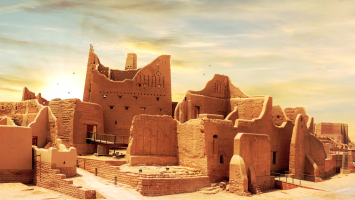Top 14 Most Beautiful Historical Sites in Macedonia
Macedonia is home to a number of varied historical sites. The Persian Achaemenid Empire, Byzantine Empire, and Romans are just a few of the groups who have ... read more...occupied the land, and have left their architectural and cultural imprint upon it as a result. Ruined fortresses, baths and towers are just a few of the sites which are a draw for any history lover. Here is Toplist's pick of the most beautiful historical sites in Macedonia which are well worth a look.
-
Kokino is a magnificent archaeological site that was found in 2001 beneath the Tatikev Kamen mountain near the village of Kokino. It is surrounded by almost 10 small villages whose total population of fewer than 1000 people.
Shortly after Kokino was discovered by Macedonian archeologists, it was also said that the site contains a megalithic observatory and sacred site. Many finds indicate that Kokino existed during the period of the Bronze Age, so there are items that date back to the 19th century BC, but there are also a few molds, ceramic vessels, and stone mills that originate from the Middle Bronze Age, from 16th to 14th century BC.
What will impress you most is the spectacular nature surrounding this archaeological site. The environment is magnificent. The various plants and tall trees together with the fresh air will make you feel completely relaxed and satisfied. Thanks to its perfect location, Kokino gives you an opportunity to capture breathtaking views of the outstanding nature that surrounds it.
Location: village Kokino, Kumanovo

Photo: Discovering Macedonia Video: Don Мacedon -
Another beautiful historical site in Macedonia you cannot pass is Varnalii Complex which belongs to the three families Paunov, Trencov, and Prnarov. The houses are built in a conventional Macedonian style and have three floors where many windows dominate the façade which is also decorated with flora and fauna originating from the surrounding area.
The House of Paunovs
It was built in 1868 in Varnaliite. The basis of the house is even, and it is developed on three different levels. The house is big, consists of a ground floor and two other floors. The balcony and the windows have a dominant position. The inside of the house is particularly impressive where the elements of the old traditional construction are predominant. To create an impression of the city's traditional architecture, the Municipality of Veles has reconstructed the house's façade.
The House of Trencovs
It was built at the same time as the house of Paunovs. Due to the specific terrain, the house stands on the street with a narrow façade, although it has a ground floor and two other floors. The ground floor and the first floor are made of stone. The architect’s solution for the second floor is especially impressive, in which dominates a room with seven windows with a view to the street. The façade of the house, whose interior is filled with traditionally crafted domestic objects, is completely rebuilt.
The House of Prnarovs
It was built in 1868 on three levels with a specific form of the basis. The ground floor's paved courtyard is an open space that is connected with the street. The central place of the architectural solution takes the balcony connecting all the rooms. On the second floor dominate the big windows and the protruding eaves which enter the roof, full of decorative elements of flora and fauna. The reconstructed façade of the house of Prnarovs features typical bays on the floors.
Location: Varnaliite, Veles

Photo: Wikipedia 
Photo: marh.mk -
Kratovo is characterized by old city Macedonian architecture, it is famous for its towers and medieval stone bridges which connect the left and the right parts of the city.
The most famous of all is Radin Bridge (Radin Most), but there are also other bridges that fascinate their beauty. The legend of Radin Bridge says that Rada was buried alive within its foundation. According to the legend, the bridge was being built by nine brothers, but it collapsed overnight. The nine brothers decided to seek the advice of the local prophet who told them to bury in the foundations the wife that first visits the construction site the next morning. Out of the nine brothers, only the youngest did not warn his wife not to visit, so when she came to bring them water and food, the older brothers threw her in the foundation and buried her alive.
The Radin Bridge is over the river Manceva, it was built in 1833 on two towers, one of which is 28 meters high and other 29 meters high. The Kratovo area is great for a road trip adventure where you can see the amazing Kuklici, the Monastery of Joakim Osogovski, Lesnovo Monastery and the Towers of Kratovo.
Location: Vera Pazavanska, Kratovo

Photo: Pinterest 
Photo: Wikipedia -
Located on the highest point of the city which is overlooking the Vardar River, Fortress Kale is one of the best places to visit in Skopje, offering a great view of the city and close to the sites of the city's Ottoman Old Bazaar.
It is believed that long time ago, during the Neolithic and Bronze ages or roughly 4000 BC, this area was inhabited. According to some studies, Kale was built in the 6th century A.D. with stone walls approximately 121 meters long and beautiful square stone towers. After the earthquake in 1963, the square towers were restored and protected from further damage.
Today, Kale represents a beautiful historic fortress and a perfect place to have relaxing time with family or friends. This beautiful historical site gives you an opportunity to enjoy observing the splendid beauty of Skopje and a chance to capture breath-taking views of Macedonia's capital.
Location: Skopje City

Photo: cityseeker Video: Camera Adventure -
Veles is home to the wonderful monument called Kosturnica which was built in 1979 to commemorate the struggles of the Macedonian people and is the eternal home of about a hundred Veles citizens who were killed during the Second World War.
Renovated in 2014, this monument inherited from the socialist period (1979) is very impressive with its shape of a large white dome located on the outskirts of the city. It is an ossuary 10m high and 15m wide, led up by stairs of 178 steps.
It's a strange, concrete, cracked-egg-shaped structure. Created by two Serbs, architect Sava Sugotin and sculptor Ljubomir Denković, this dome is reminiscent of a German soldier's helmet from the Third Reich broken into four pieces. The Kosturnica Monument has a five-part art painting on the walls which shows the Macedonian aspirations for freedom and the battle the nation fought for it. There is a museum inside this building that displays documents telling the history of the town during that period.
Location: Veles
Photo: Twitter Video: For 91 Days Travel Blog -
The Memorial House of Mother Teresa, as the name suggests, was opened in 2009 in order to pay homage to the incredible person and Noble Prize winner from Macedonia, Mother Teresa. The house was built in the exact spot where the old Catholic Church 'Sacred heart of Jesus' used to stand.
In this church, she sang in the choir and it was the church where Gonxha Bojaxhiu found her inner peace after the death of her father, thus this place is perfect for this Memorial House. The Memorial House has splendid design and architecture. It has a gallery, chapel and amphitheater, all of which have significant meaning. The decoration of the gallery features the interior of a Macedonian city house in the early 20th century. Above the gallery, there is a beautiful chapel where the priests from the Catholic Church hold services twice a week. In the lower part of the house, there is an amphitheater where numerous educational projects, exhibitions and promotions related to Mother Teresa's work take place.
The Memorial House of Mother Teresa is located in the heart of Skopje city, on the famous Macedonia Street, thus it is easily accessible for anyone who wants to learn more about Gonxhe Bojaxhiu's precious humanitarian work.
Location: MK, Macedonia St 1000, Skopje

Photo: Secret-World Video: light2tube -
Situated in the old town of Ohrid, between the two hills Gorni Saraj and Deboj, the Ancient Theatre is one of the most beautiful historical sites in Macedonia which tells a lot about the rich history of the country.
The Theatre is an example of buildings that belong to the Hellenistic period. It is actually the only construction in Macedonia that originates from this period and it was built 200 BC. Later during Roman times, the Theatre was used for gladiator fights and was a place where Christian people were executed by the Romans. Because of this, the theatre soon became detested by locals and later was destroyed by them. Nowadays, the Ancient Theatre is not fully preserved, only the lower parts for seating and the place where the stage was still exist.
Today, the Ancient Theatre in Ohrid is a place where the annual Ohrid Summer Festival occurs, many manifestations and cultural events during the whole year can also be seen on the stage of the Ancient Theatre.
Location: Brakja Miladinovci, Ohrid

Photo: Curiously Erin Video: Turguide -
The old Clock Tower in Dojran is one of the few monuments of this small lakeside town that provide a visual record of its turbulent times. Although the exact date about when this clock tower was built is not known, experts presume it's from the end of 14th century when Dojran was occupied by the Ottoman Empire, close to 1372.
The Clock Tower was probably the most dominant building in past Dojran and as its name suggests it was used to tell the time for all travellers and residents of Dojran. It is assumed that the Clock Tower in Dojran was built by the Ottoman general Evrenos after his army marched on to Dojran through the frozen waters of the lake, so the legend goes.
Although nowadays only a fraction of the original size of the clock tower remains, it is a witness to many events that since then shaped the future of this small but popular town.
Location: Anton Panov, Dojran
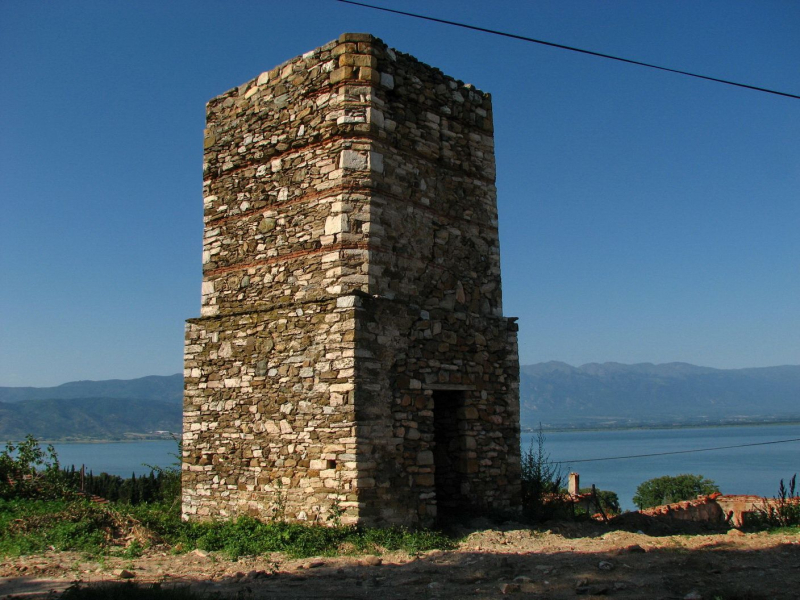
Photo: Pinterest 
Photo: Wikimedia Commons -
Dorjan is a beautiful city with many monuments which tell a lot about its rich history and culture. Dojran was destroyed, built, burnt and reconstructed several times. That is the main reason why in the city, there are many churches, clock towers, schools and baths which stem from different periods, cultures and people.
One of the most beautiful historical sites in Macedonia as well as in Dojran in particular, bears the name Amam which is a Turkish word for bath. This Turkish Bath was very popular and frequented by many people as it was the only one in the city. It is not known when the Amam was built, but it is believed that it was open every day until 1916 when it was destroyed. These days, only ruins left from this beautiful building but it is proved that it consisted of several rooms and in each room there was a faucet. There were rooms for men and women separately, the water was heated in a huge kettle and transported to these rooms through tubes.
It is interesting the fact that despite Turkish, the Bath was visited by people from different nationalities and today it is a significant cultural monument and popular place in Dojran.
Location: Anton Panov, Dojran

Photo: Travel to Macedonia 
Photo: Travel to Macedonia -
Makedonium, also known as Ilinden Memorial, is a beautiful historical site from the city of Krushevo located in the southern part of Macedonia. The monument represents most commonly the Ilinden uprising.
The Makedonium Monument was officially opened on 2 August,1974, the 30th anniversary of the Second Session of the Anti-fascist Assembly for the National Liberation of Macedonia and the 71st anniversary of Ilinden uprising. It is dedicated to all the soldiers and revolutionaries who took part in the Ilinden uprising, as well as soldiers-partisans of the Macedonia National Liberation Struggle 1941-1944.
The monument's grounds cover 5 hectares (12 acres). The building is round in shape with protruding oval windows. The upper windows are made of stained glass. There is the tomb of Nikola Karev, president of the Kruševo Republic, and the bust of the singer Toše Proeski inside the dome. Inside the dome there are four windows, each facing a different direction including the locations linked to the Ilinden-related events ″Sliva″ Memorial, Bear stone and Pelagonija.
The monument complex also has a plateau with series of sculptures named "Breaking the Chains", symbolizing freedom won in the liberation wars. There is also a crypt with the carved names and important events associated with the period before, during and after the Ilinden uprising. The last element is the amphitheater adorned with colorful mosaics.Location: Krushevo

Photo: Wikimedia Commons Photo: Unlimited Travelers Corp. -
Located on the west side of Shtip, between the Bregalnica and Otinja rivers, you can see a rocky hill on which the Isar Fortress is situated.
It is not known exactly when the fortress was built but it is known that it dates back to the Middle Ages because of all its medieval artistic features. On all four sides of the Isar, churches were constructed to protect the fortress. In 1332 a church dedicated to St. Archangel Michael was built, then in 1337 was erected another church dedicated to St. Vasilie, and the third church dedicated to St. Nikola was built in 1341. Several years later, the fourth church was built, which today is still preserved in its original form.
During its existence, the fortress went through several occupations but the Turkish authorities left huge marks on it as the Isar was destroyed during that period. Although the fortress was 19m high, today it remains mostly in ruins with very few preserved parts from the entire construction process. Despite being ruined, the fortress is still visited by locals and tourists who learn a lot about the history of this place and at the same time enjoy spectacular views of the city.
Location: Shtip

Photo: Wikimedia Commons Video: Nature -
Kocho Racin (Kosta Apostolov Solev) is one of the most outstanding Macedonian poets and revolutionary that lived a relatively short life (1908-1943) but made a great influence on the development of Macedonian literature. His most well-known work is the collection of poems named White Dawns that sold in more than 4,000 copies not only in Macedonia but in the surrounding region as well.
The Memorial House is the real house of Kocho Racin who was born in Veles. The house was built on the left side of the Vardar River and reflected the traditional Veles house, which nowadays is considered the type of house with the most appealing architecture. The house was constructed in the late 19th century and consists of a stone ground floor, a prominent white façade on the first floor, and a steep roof covered with tiles.
The house underwent full reconstruction in 1963; however, it has maintained its authentic appearance and typical of the old Macedonian houses, it presents a ground floor and a first floor. Racin’s pottery workshop and the kiln in which he fired the clay products are on the ground floor. The upper floor has two rooms, a kitchen and a guest room, as well as a chardak with a breathtaking view of the old town.
On the chardak, there's a permanent exhibition of documents and objects that belonged to the great poet, whose poem collection White Dawns is the most translated book by a Macedonian poet. The Memorial House represents his initial manuscripts along with many other memorabilia from his life and work. There showcased 31 love letters and cards from Kocho Racin to Rahilka Firfova-Raca, several of which were written with his blood in the 1920s.
Racin’s house is most visited during “Racin Meetings” and “Children’s Racin Meetings”, which are held in his honor. During the summer, a pottery workshop took place at the Memorial House, where top Veles potters teach the interested students about the fundamentals of pottery, preventing this craft from dying out.
Location: Kocho Racin Str., Veles
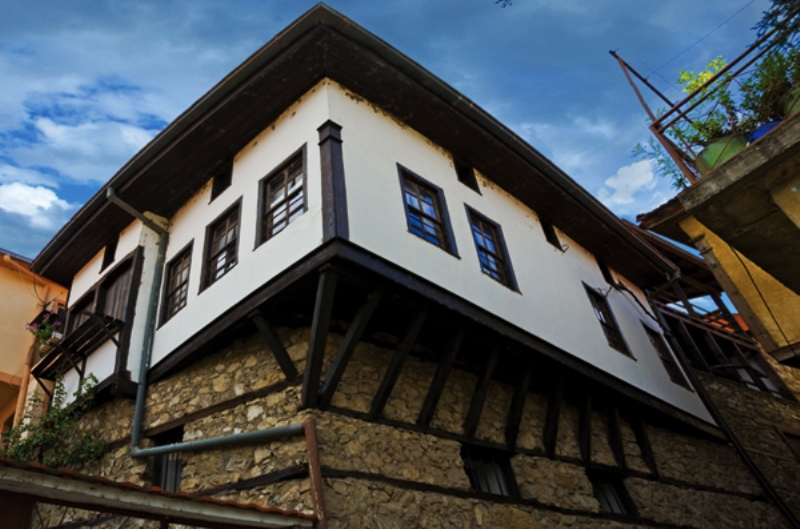
Photo: MAPX 
Photo: Travel to Macedonia -
Stone Bridge in Skopje is among the greatest monuments of its kind. It is a bridge across the river Vardar, which today connects the old and the new part of the Skopje city. The bridge was built in the second half of 15th century and form solid stone blocks, while its massive construction depends on firm pillars interconnected with 12 semicircular arches.
Crossing over the bridge, you don't just cross over to the opposite bank of the river Vardar. This bridge also combines the cultures rooted and blooming in a single place, in the same city of Skopje, thus the bridge depicts a corridor of civilization. These days, same as six centuries ago, people use the bridge to cross from the new city centre filled with coffee places to the Old Bazaar.
Stone Bridge is located in the central area of the city and is one of the main tourist attractions, it has been a symbol of Skopje for centuries and is the main feature of the coat of arms of the city, which in turn is merged in the city's flag.
Location: Skopje

Photo: Wikipedia Video: Turguide -
Placed within the heart of Skopje, the Old Bazaar has explicitness and dynamics of its own kind. The Old Bazaar is your closest destination in Skopje, regardless of where you enter the city from. A survivor of many wars and occupations, the Bazaar continues to be the oldest living witness of this region's history. Yet, it remains a symbol of cosmopolitanism of Skopje: many cultures and civilizations, many religions and lots of traditions come across and meet each other in the Old Bazaar.
Today, it's an eyewitness to an extended and complex process of social development which unfolds with the expansion of trade and it comes to its peak with the cultural development of the capital city of Macedonia. The Old Bazaar offers a variety of tourist attractions, from food to cultural and historic testimonials.
Although Ottoman architecture is predominant, remains of Byzantine architecture are obvious as well, while recent reconstructions have led to the application of elements specific to modern architecture. The Old Bazaar is still home to several active mosques, türbes, two churches and a clocktower, that, along with the buildings of the Museum of the Republic of North Macedonia and the Museum of Modern Art, form the core of the modern bazaar, making it one of the first places to visit in Skopje and the most beautiful historical sites in Macedonia.
Location: Skopje
Photo: Flickr Video: Urban Makedon
















